V is for . . .
In addition to “V” for “Virus,” we can add that “V” stands also for “Vaccine.” Furthermore, “V” is for “Victory.” At least in the healthcare sector, America Has Been Made Great Again.
One of the architects of that victory is Gen. Gustave Perna, a four-star who took leave from the U.S. Army’s Materiel Command to become chief operating officer of Operation Warp Speed (OWS); as Perna explained the stakes of the struggle at a press briefing on December 12:
We’re at war with this virus . . . distribution has begun . . . Make no mistake . . . the vaccine is the beginning of the end.
In fact, even as the general was speaking, the first batches of vaccines, the fruit of OWS, went trucking and winging their way across the country.
Continuing in that tough-minded tone, Perna compared the moment to D-Day, the watershed feat of arms in which Nazi Germany’s fate was sealed. Being the general that he is, Perna has nailed it: We are at war with the virus. That is, the virus is trying to kill us, and so we’d better kill it first.
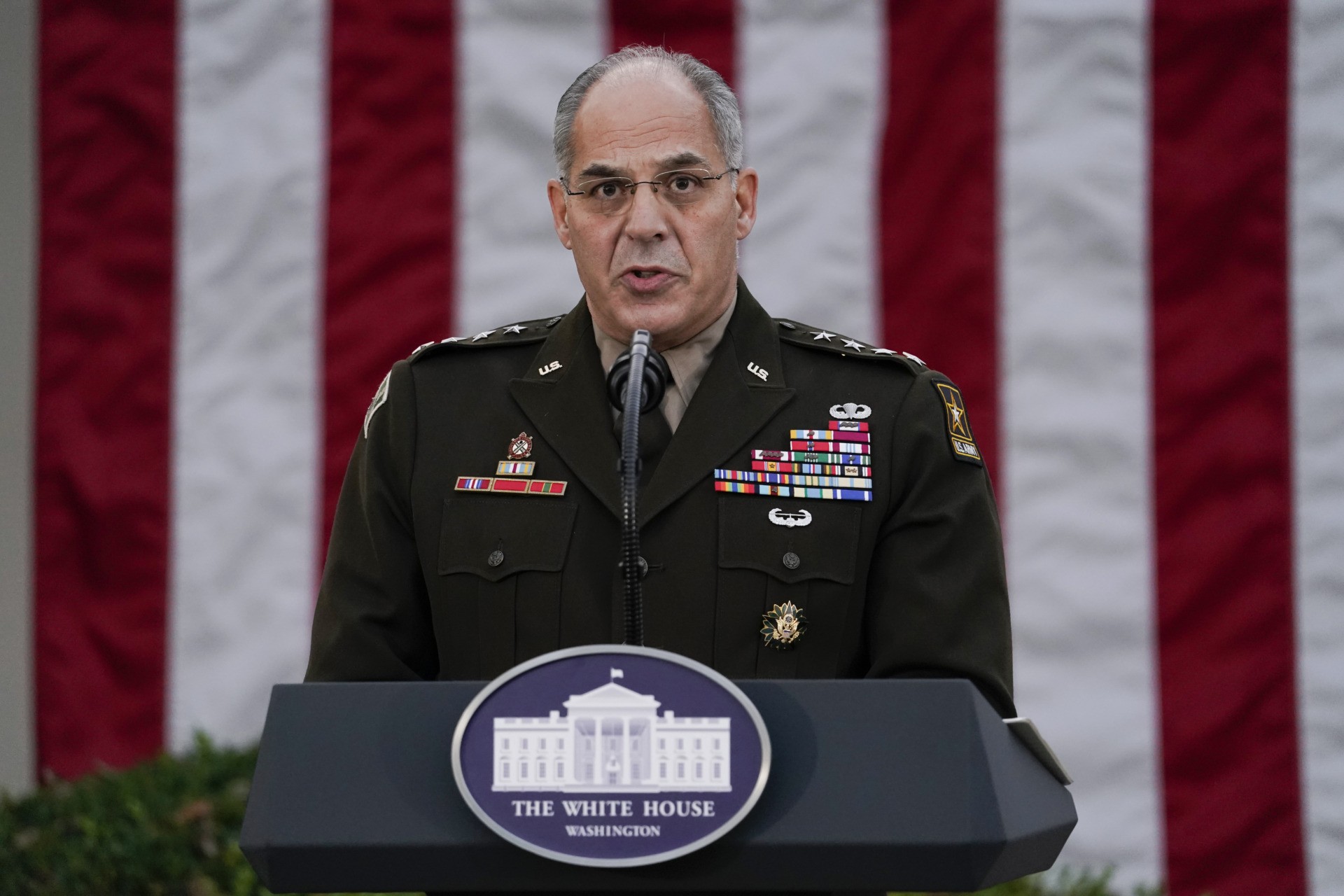
Army Gen. Gustave Perna, who is leading Operation Warp Speed, speaks during at an event in the Rose Garden of the White House, Friday, Nov. 13, 2020, in Washington. (AP Photo/Evan Vucci)
Another hero of OWS is Health and Human Services Secretary Alex Azar; he’s a civilian, and yet he has the same warrior ethos; as he wrote recently, “Through a military-style battle rhythm, OWS has been working to mitigate potential problems and setbacks, planning with a precision that marks the U.S. military.”
Of course, success in the military—success in anything, really—depends on a combination of strategy and resources: Early on, President Trump invoked the Defense Production Act to get the vaccine on the fast track; in addition, OWS invested more than $10 billion in laboratories and companies across the nation, all proceeding at the same time toward the same goal with the laurels going to the swiftest. The result, Azar concluded, is that “Operation Warp Speed will go down as one of the great scientific achievements in our country’s history.”
Speaking of history, according to reports, Arthur Herman’s 2013 book Freedom’s Forge: How American Business Produced Victory in World War II was often invoked in OWS meetings, where “dozens of military officers reported to work in uniform.”
So we can see: OWS was run in the same manner that defense production was run during the Good War—and that’s fitting, since this, indeed, has been another Good War. (As this author argued in a four-part series for Breitbart News back in 2017, it’s entirely appropriate to look to military mobilization as the model for medical mobilization—because whether the enemy is a nation or a pathogen, it’s a war that has to be won.)
On December 11, President Trump himself added another strategic layer to the success of OWS:
When the China virus invaded our shores, I promised that we would produce a vaccine in record time before the end of the year. They said it couldn’t be done. But with today’s announcement, we have now achieved that goal.
Trump is right about China, and he’s also right when he says that “they”—the naysayers—insisted that it couldn’t be done, over and over again. Amber Athey, writing for The Spectator (U.K.), has kept track of all the misleading, even deceptive, headlines, such as this gem of wrong-headed negativity: “Trump says COVID-19 is vaccine coming ‘within weeks.’ Experts say that’s not possible.”
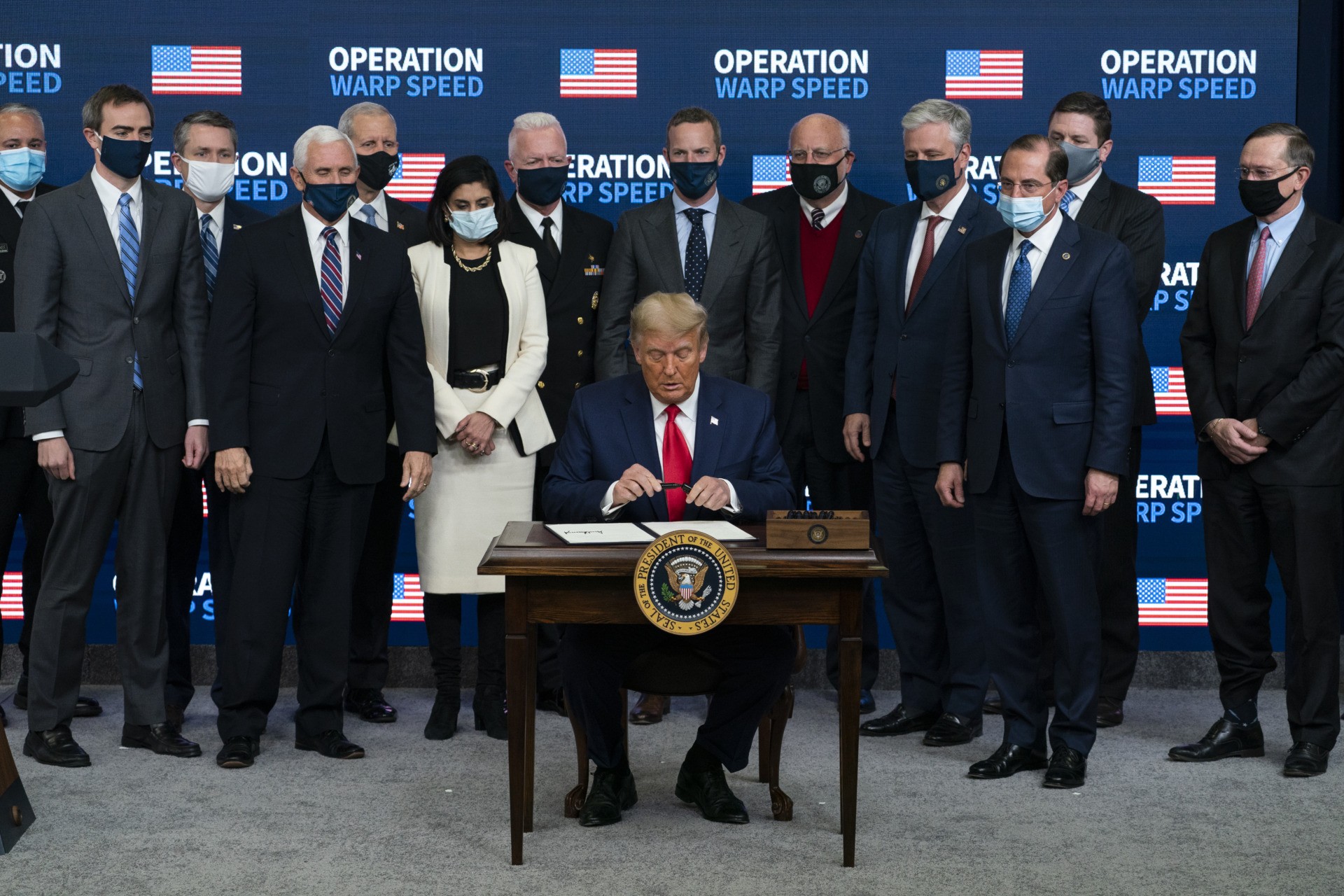
President Donald Trump puts a top on his pen after signing an executive order on vaccine distribution during the “Operation Warp Speed Vaccine Summit” on the White House complex, Tuesday, Dec. 8, 2020, in Washington. (AP Photo/Evan Vucci)
Doing the impossible: That’s something we associate with World War II; the motto of a hero outfit, the Navy Seabees, for instance, is a pithy two words: “Can Do.” So now we know that Can Do is not just in our history, it’s also in our current vocabulary.
Yet OWS wasn’t just about the military, and the military spirit, by itself; it was also a partnership with private industry. As Trump said:
Operation Warp Speed is the greatest medical manufacturing endeavor in American history. . . . Today’s achievement is a reminder of America’s unlimited potential when we have the will and the courage to pursue ambitious goals.
We might also note that the Pfizer vaccine is being made at its largest manufacturing plant in Kalamazoo, Michigan. Ah, Michigan. Over the years, Breitbart News has remembered the key contribution of the Wolverine State to the building up of our strength in World War II; back in 2017, we highlighted the giant plant at Willow Run in Ypsilanti, Michigan, praising both the factory and its workers.

Ford’s Willow Run plant in Ypsilanti, Michigan, where the B-24 Liberator bombers were built during World War II. This photo from March 3, 1943, shows workers assembling the final touches on the wing section of the bombers. At peak production, the Willow Run Plant was building one B-24 bomber every hour. (AP Photo)
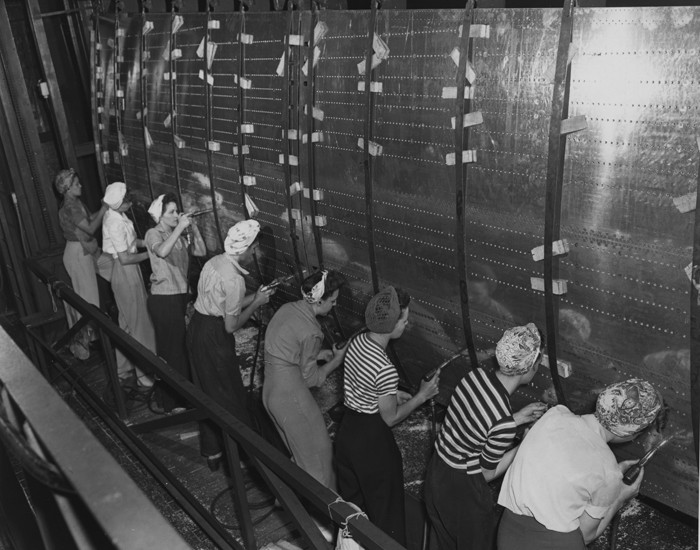
“Rosie the Riveter” — women workers riveting a B-24 Liberator bomber, circa 1944, at the Ford Willow Run plant in Ypsilanti, Michigan, during World War II. (Source: The Henry Ford/Flickr)
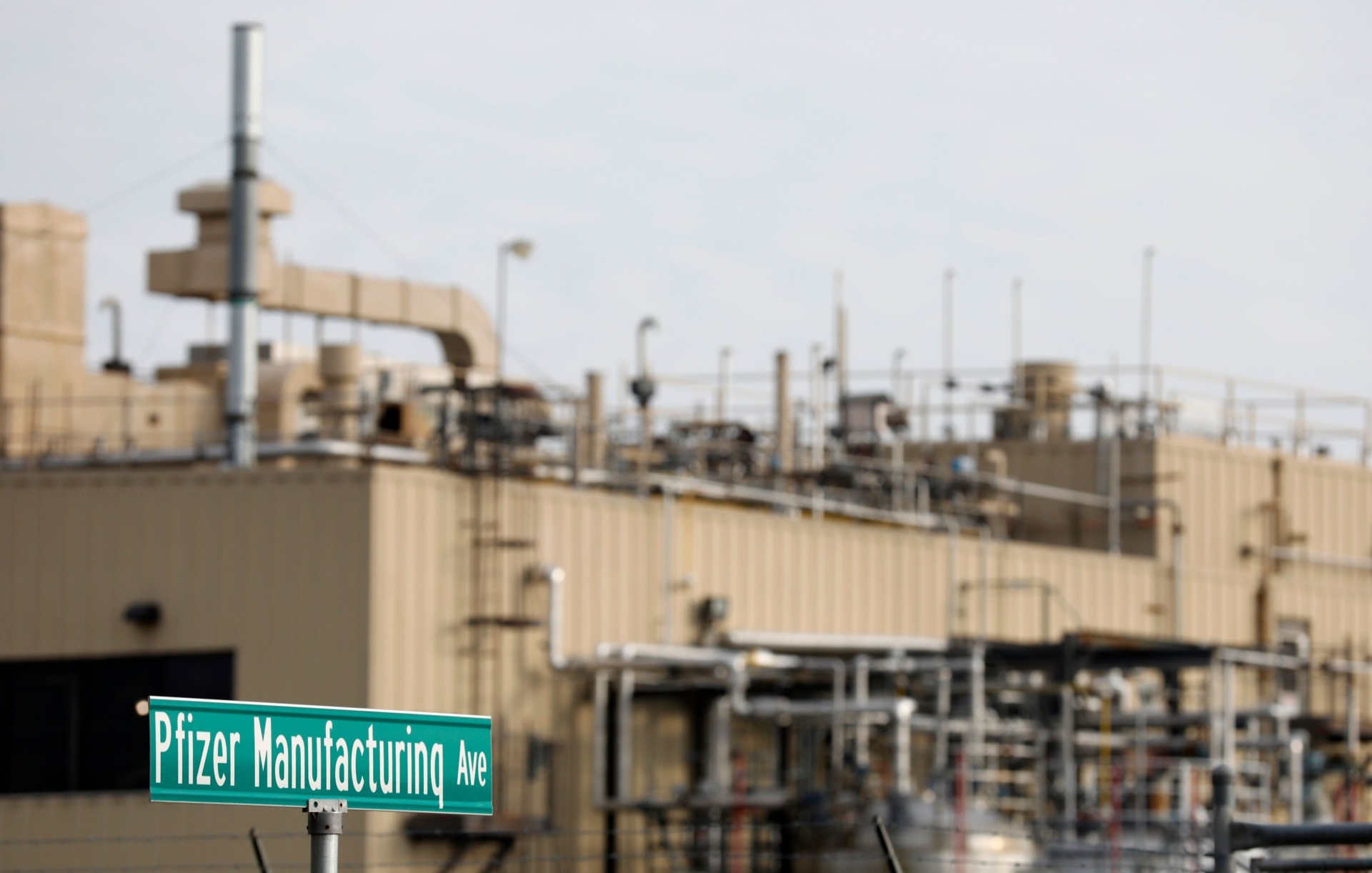
Pfizer’s Global Supply facility in Kalamazoo, Michigan, where Pfizer’s Covid-19 vaccine is being produced. (JEFF KOWALSKY/AFP via Getty Images)
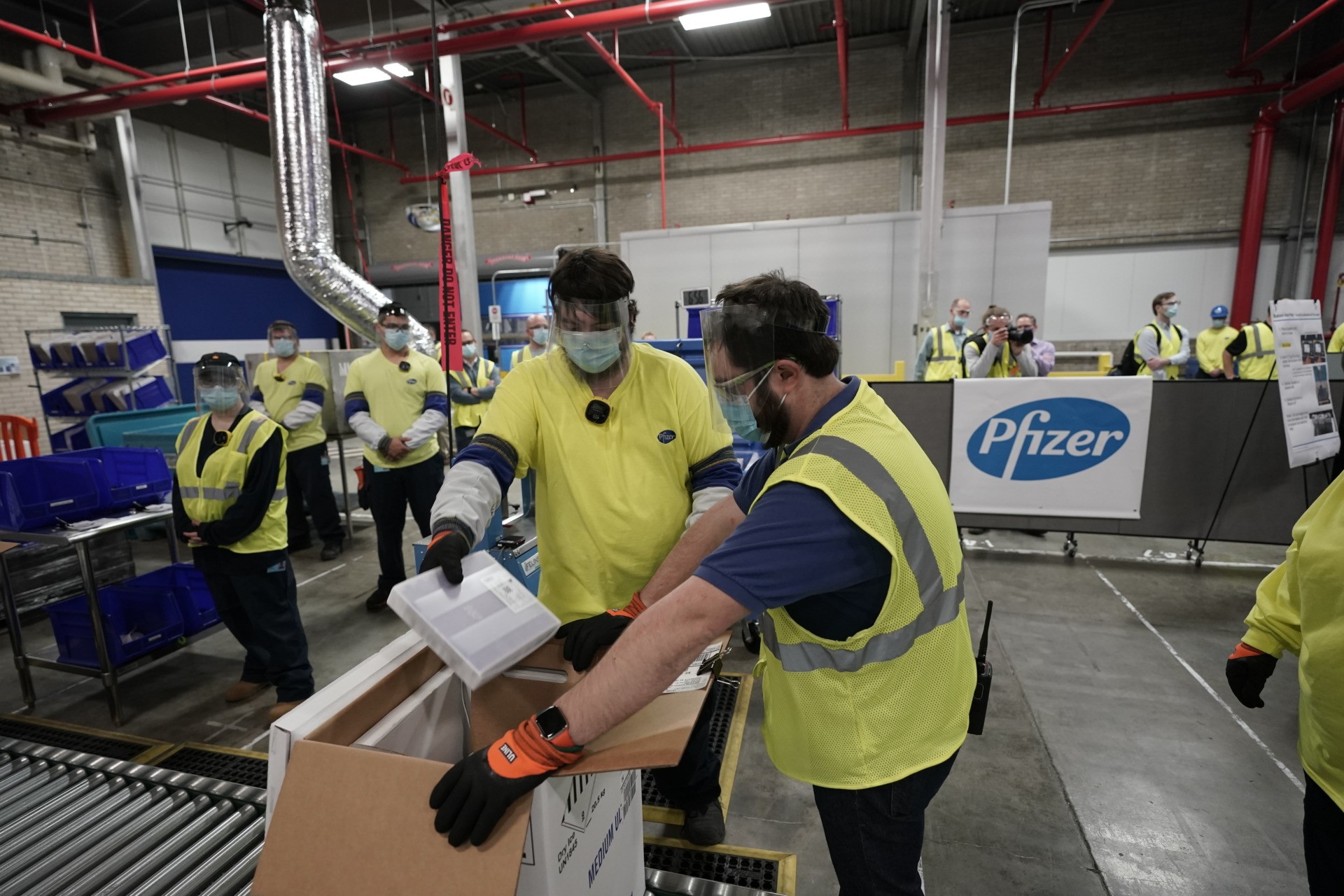
Boxes containing the Pfizer-BioNTech COVID-19 vaccine are prepared to be shipped at the Pfizer Global Supply Kalamazoo manufacturing plant on December 13, 2020 in Michigan. (Morry Gash/Getty Images)
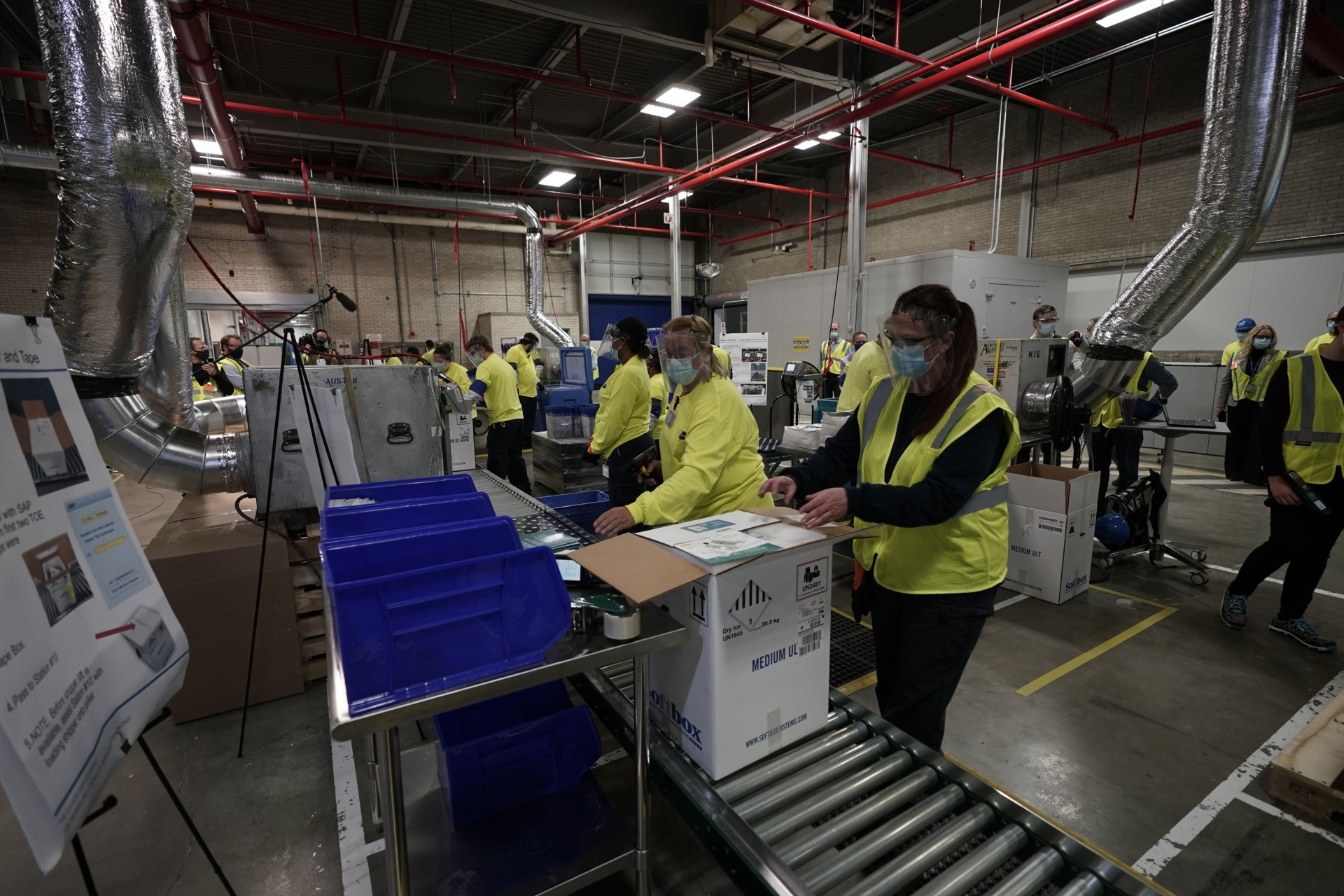
Boxes containing the Pfizer-BioNTech Covid-19 vaccine are prepared to be shipped at the Pfizer Global Supply Kalamazoo manufacturing plant in Michigan on December 13, 2020. (Morry Gash/Getty Images)
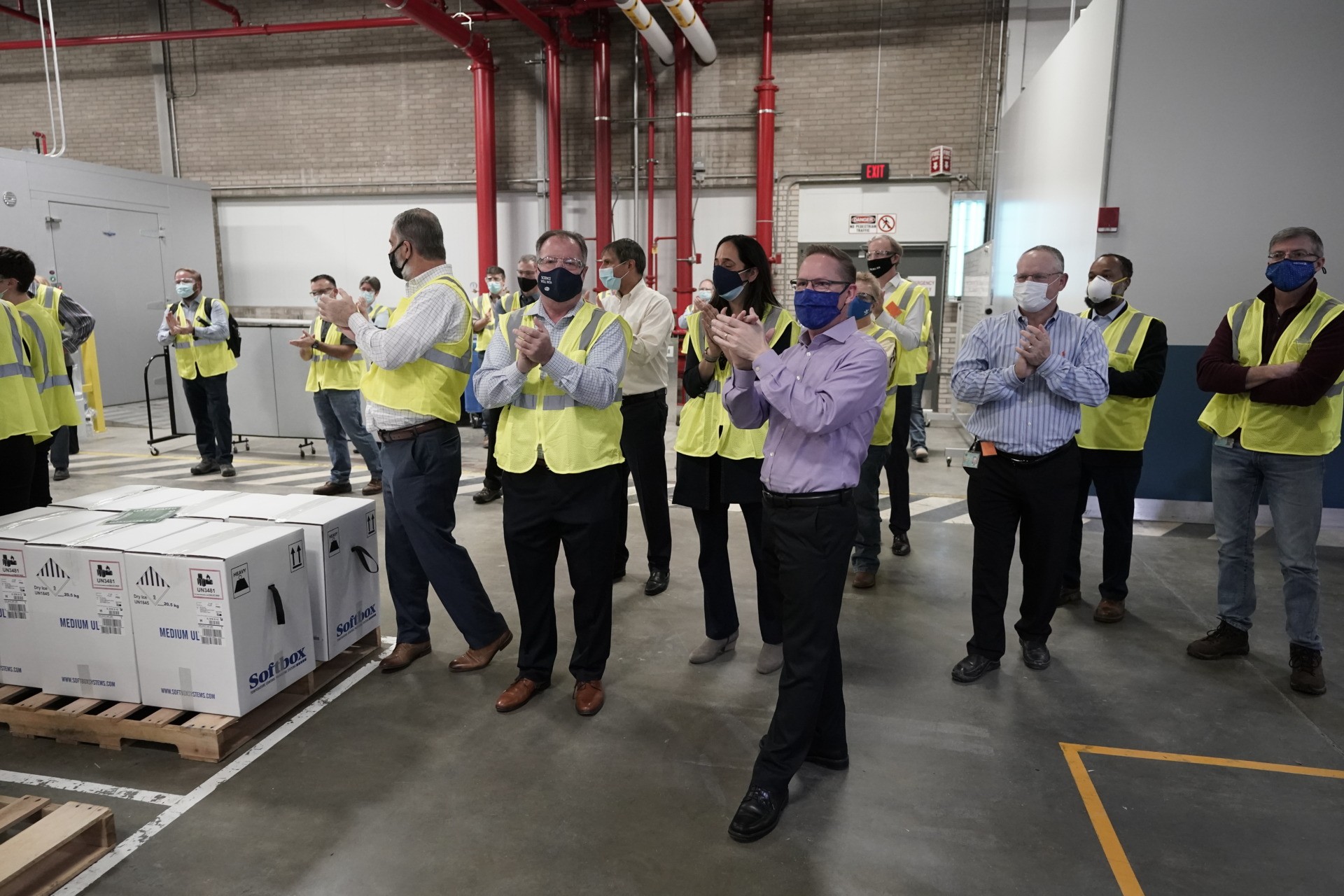
People applaud as boxes containing the Pfizer-BioNTech COVID-19 vaccine are prepared to be shipped at the Pfizer Global Supply Kalamazoo manufacturing plant on December 13, 2020 in Michigan. (Morry Gash/Getty Images)
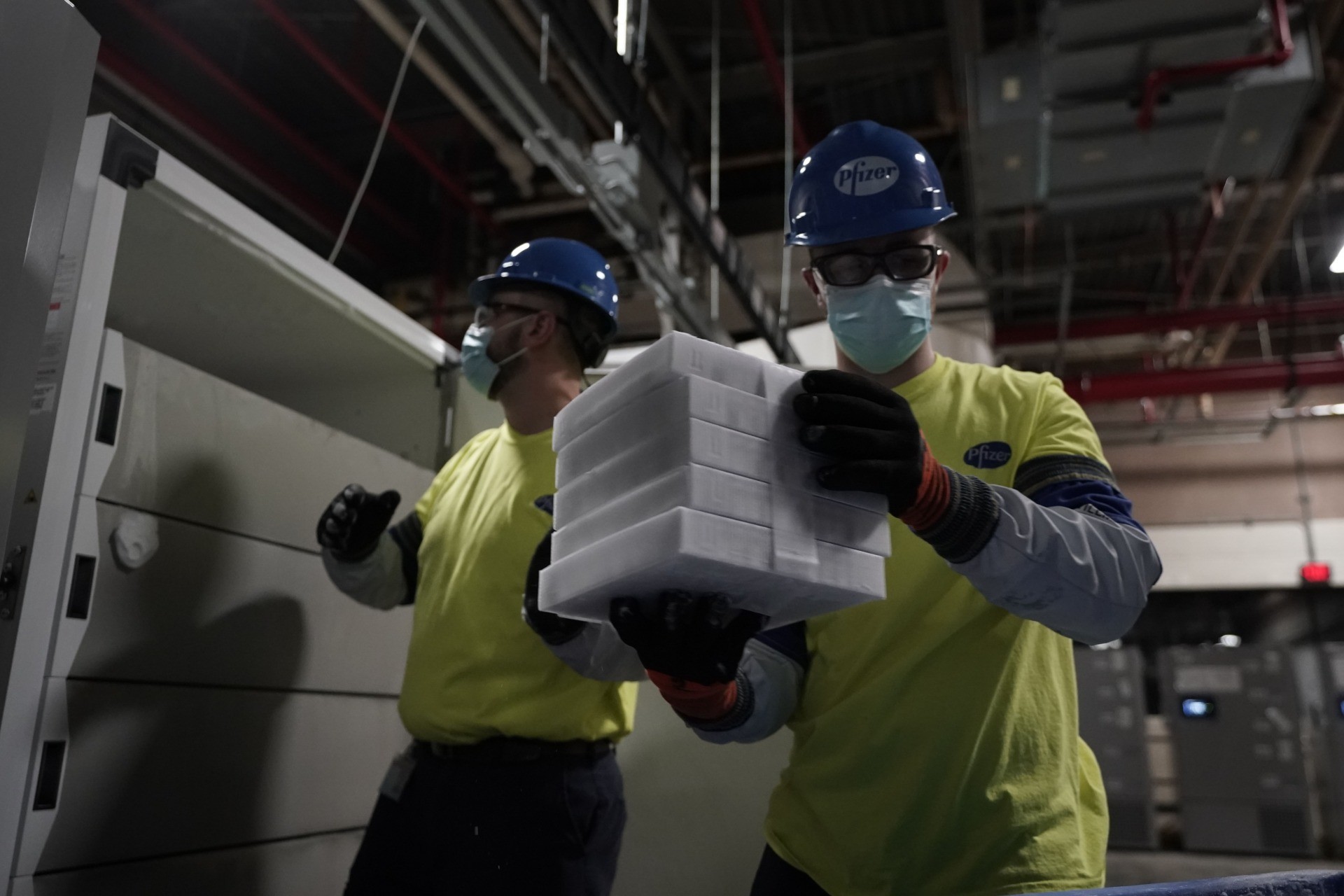
Boxes containing the Pfizer-BioNTech Covid-19 vaccine are prepared to be shipped at the Pfizer Global Supply Kalamazoo manufacturing plant in Kalamazoo, Michigan on December 13, 2020. (Morry Gash/Getty Images)
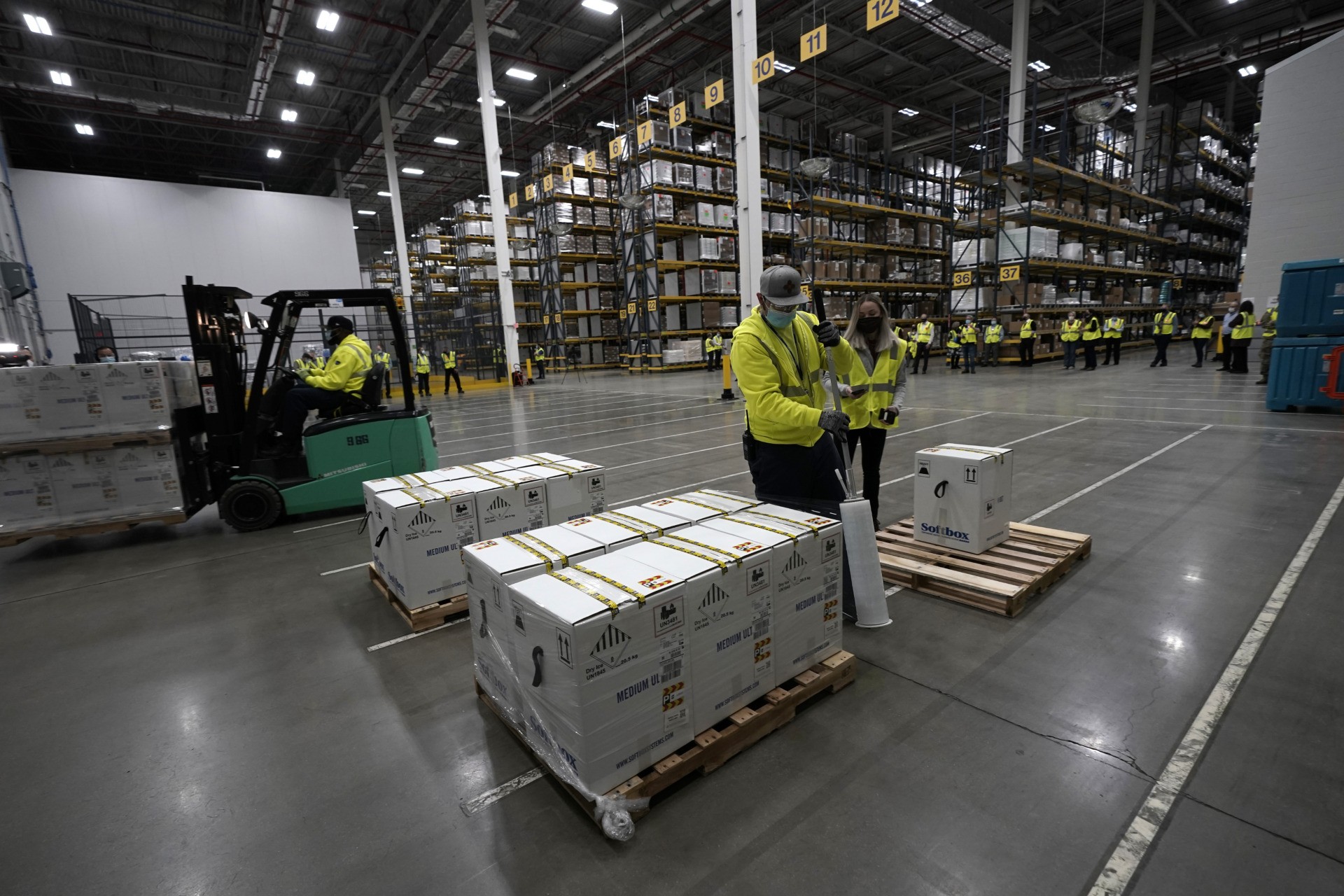
Boxes containing the Pfizer-BioNTech COVID-19 vaccine are prepared to be shipped at the Pfizer Global Supply Kalamazoo manufacturing plant in Michigan on December 13, 2020. (Photo by Morry Gash/Getty Images)
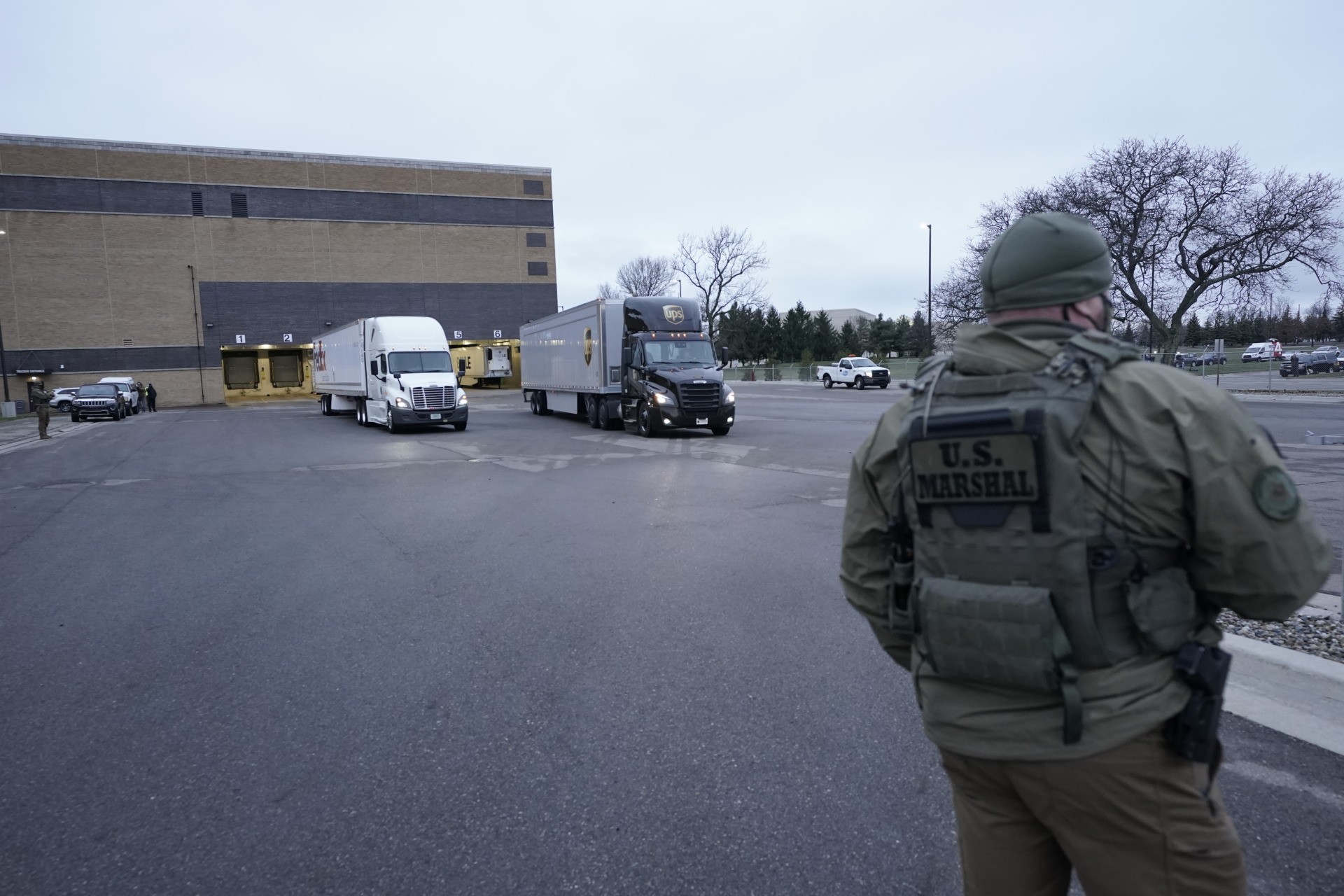
A U.S. marshal stands guard as trucks containing the Pfizer-BioNTech COVID-19 vaccine are loaded at the Pfizer Global Supply Kalamazoo manufacturing plant in Michigan on December 13, 2020. (Morry Gash/Getty Images)
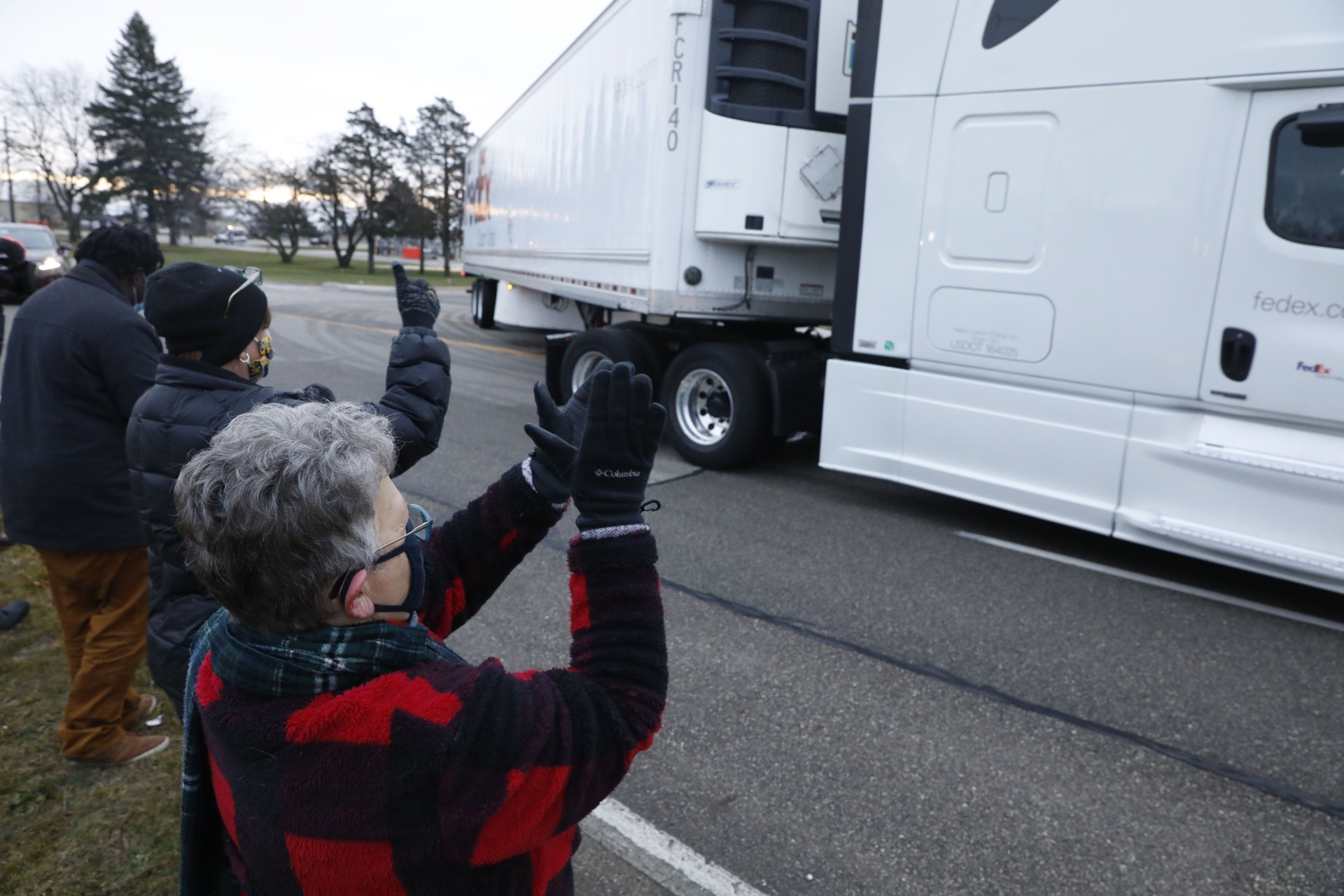
Nancy Galloway (L) and Susan Deur cheer as trucks carrying the first shipment of the Covid-19 vaccine are being escorted by the U.S. Marshals Service, leaving Pfizer’s Global Supply facility in Kalamazoo, Michigan on December 13, 2020. (JEFF KOWALSKY/Getty Images)
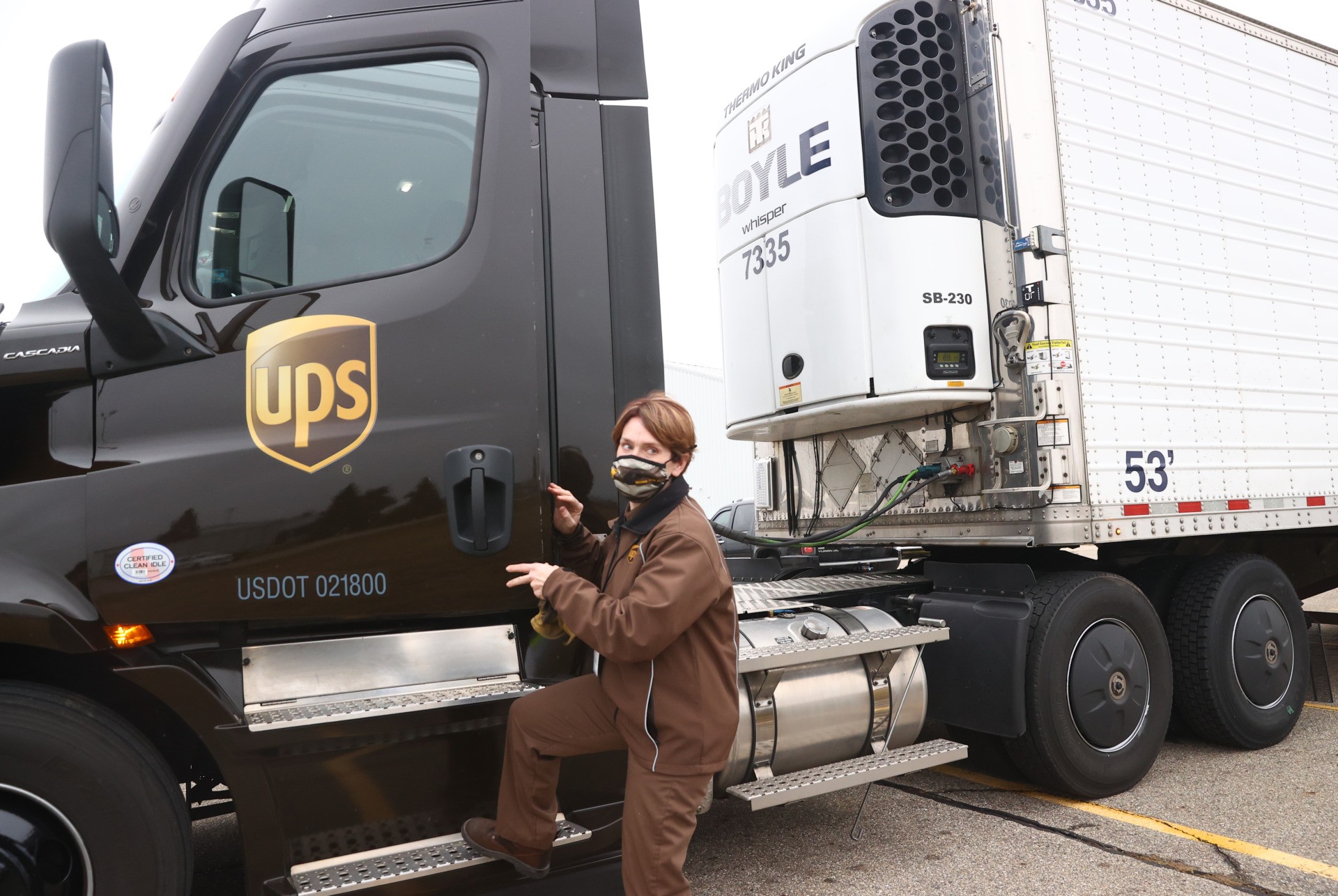
A UPS worker hooks a UPS truck to a trailer containing the first shipments of the Pfizer And BioNTech COVID-19 vaccine at the Capital Region International Airport on December 13, 2020 in Lansing, Michigan. (Rey Del Rio/Getty Images)
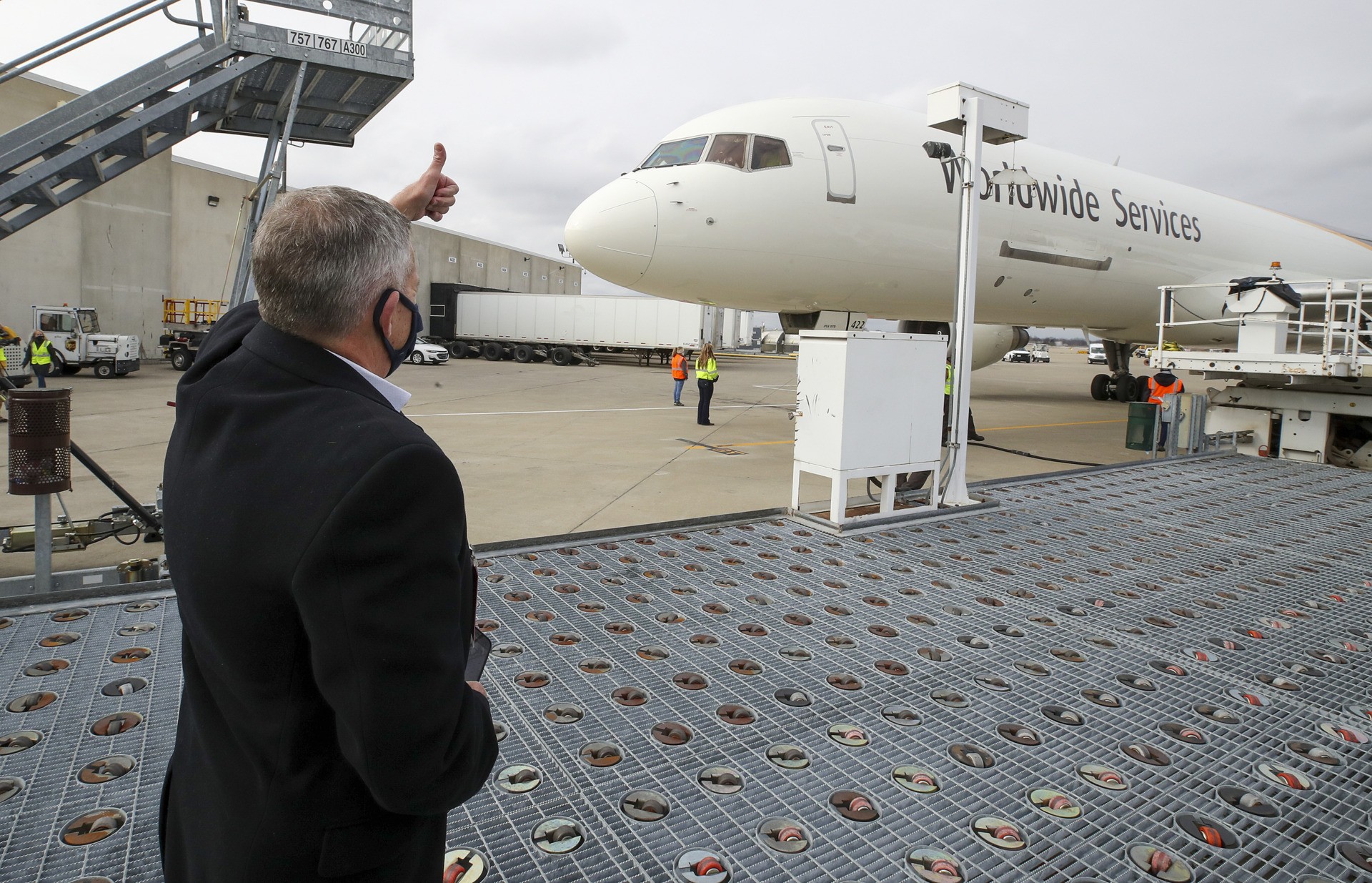
Wes Wheeler, President of UPS Healthcare, gives a thumbs up to Captain Houston Mills, VP of flight operations for UPS, after landing with a cargo containing the first shipments of the Pfizer and BioNTech COVID-19 vaccine on December, 13, 2020 at UPS Worldport in Louisville, Kentucky. The flight originated in Lansing, Michigan. (Michael Clevenger/Getty Images)
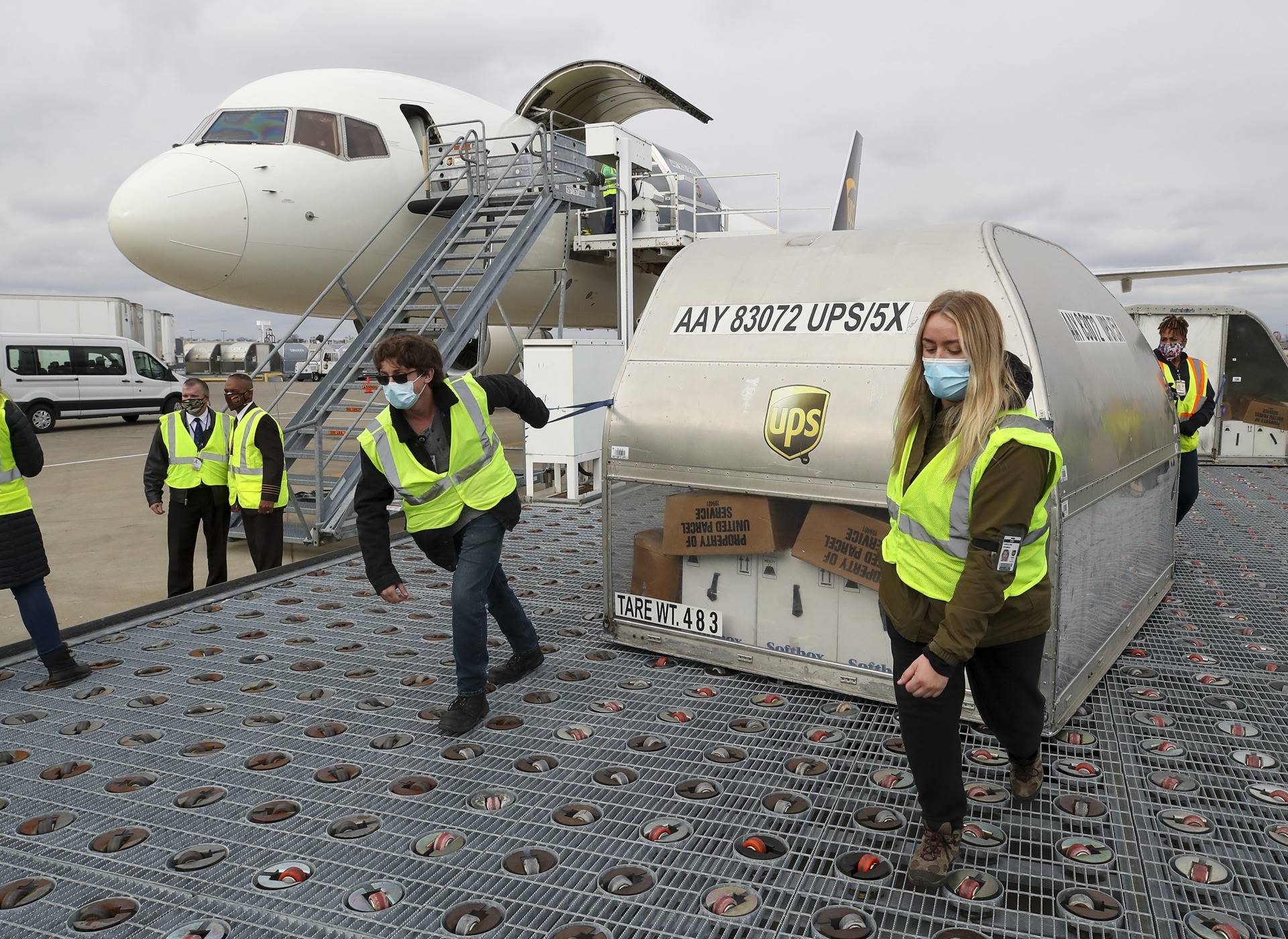
UPS workers move one of two shipping containers containing the first shipments of the Pfizer and BioNTech COVID-19 vaccine a ramp at UPS Worldport in Louisville, Kentucky, on December 13, 2020. (Michael Clevenger/Getty Images)
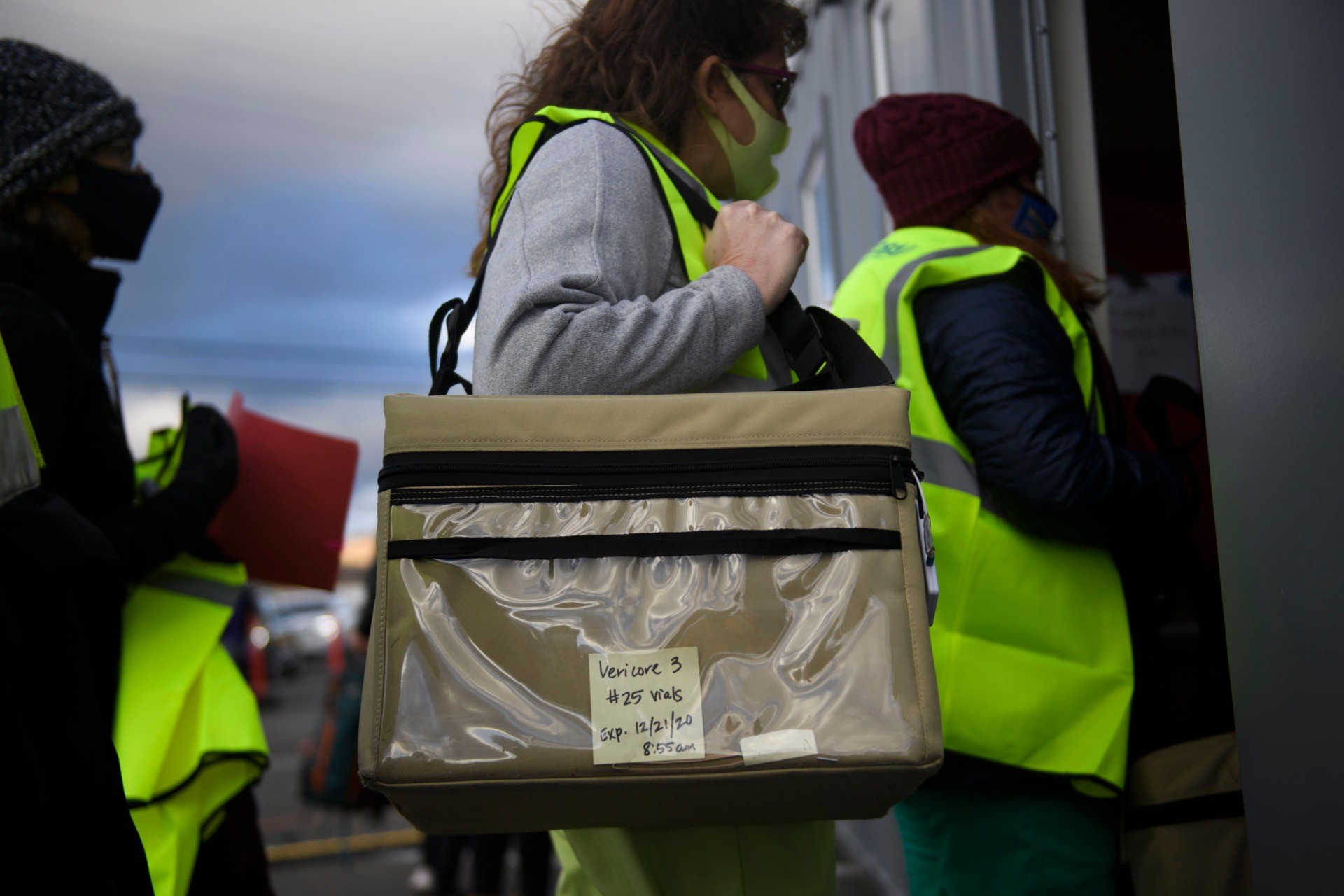
Washoe County Health District staff carry specialty coolers with Pfizer-BioNTech Covid-19 vaccines to be administered to front-line health care workers at a drive up vaccination site from Renown Health on December 17, 2020 in Reno, Nevada. (Patrick T. Fallon/Getty Images)
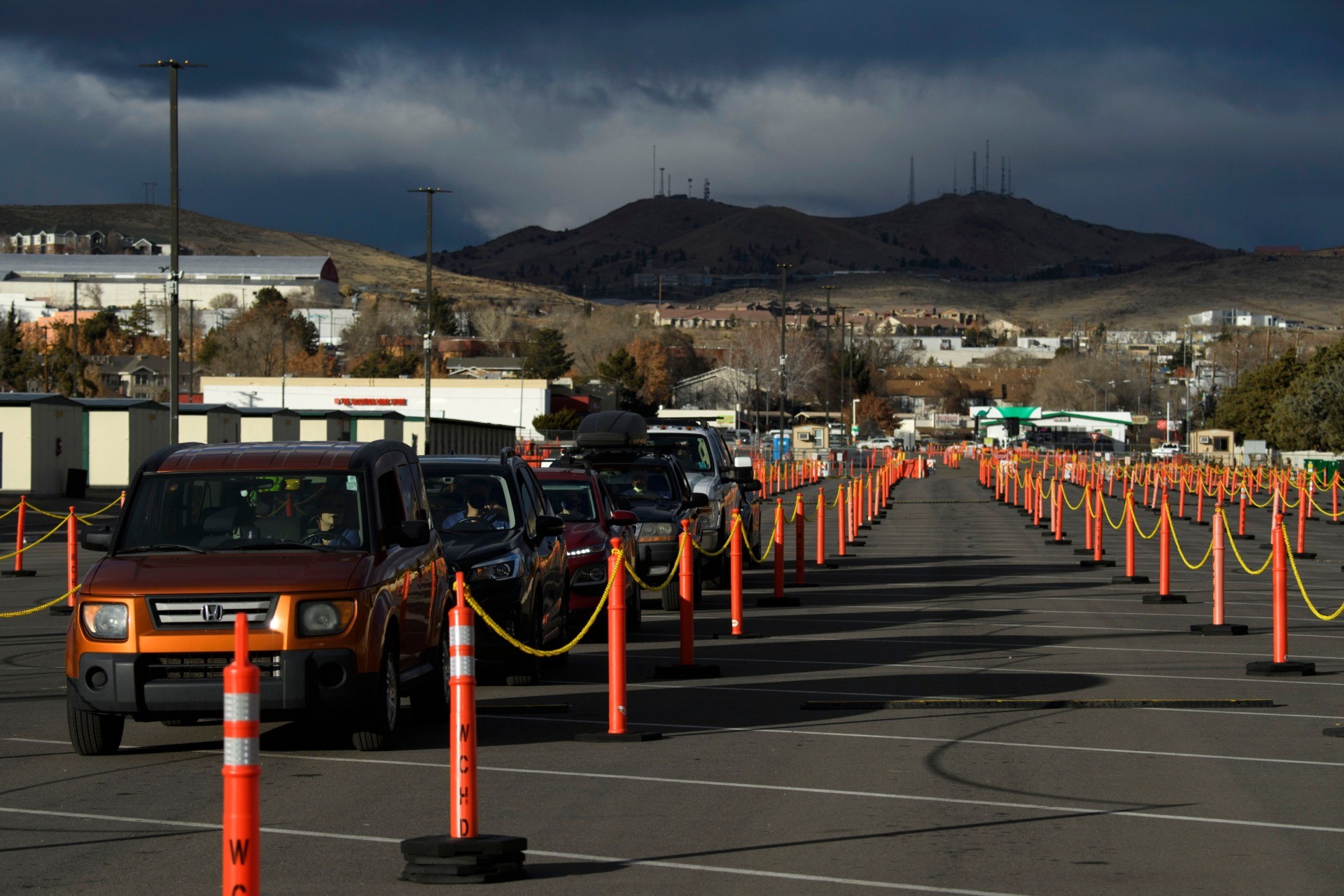
Front-line health care workers wait in their cars to receive their first dose of the Pfizer-BioNTech Covid-19 vaccine at a drive up vaccination site from Renown Health on December 17, 2020 in Reno, Nevada. (Patrick T. Fallon/Getty Images)
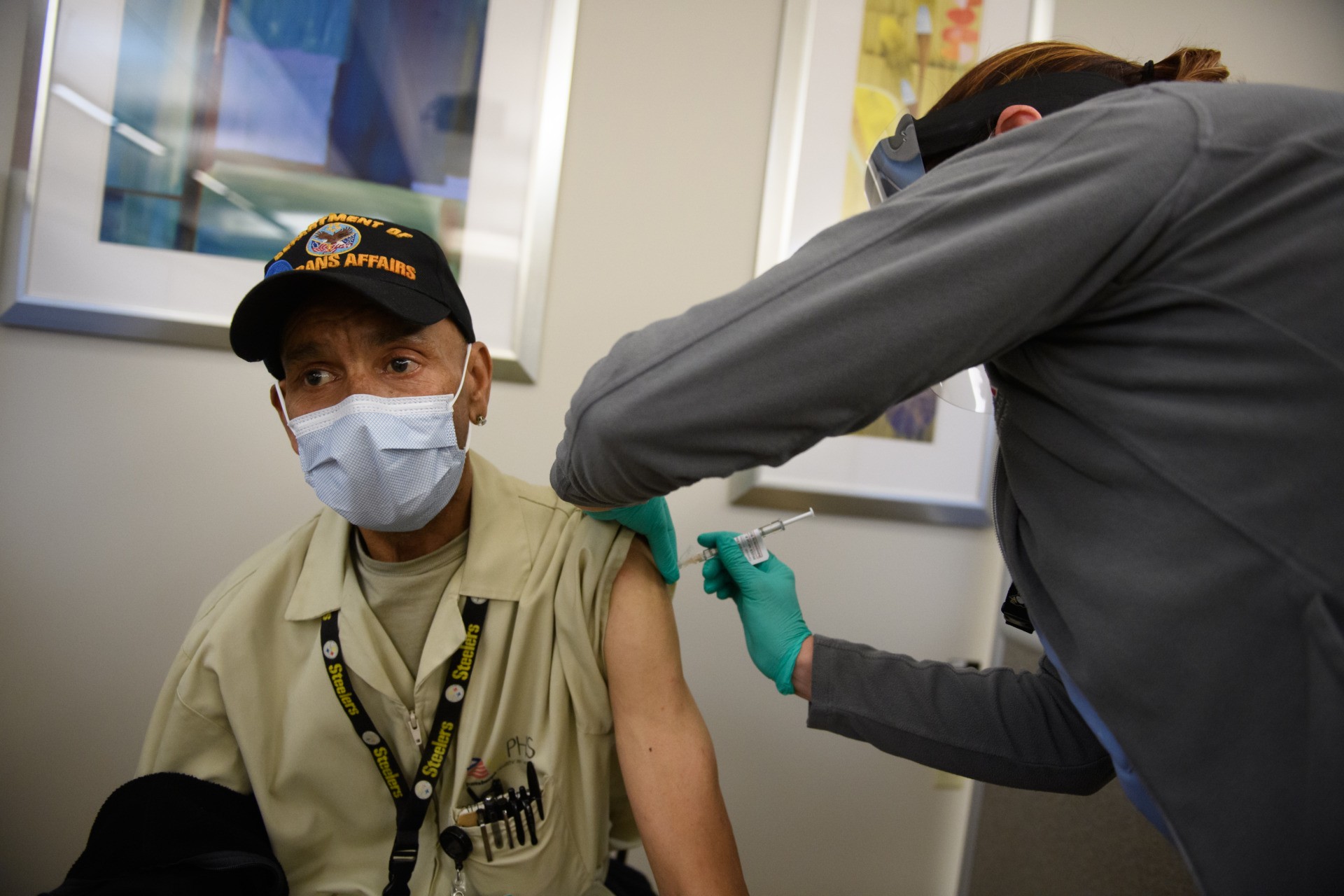
VA Hospital Housekeeper Eugene Proctor, 60, receives a COVID-19 vaccine at the Pittsburgh VA Medical Center on December 17, 2020 in Pittsburgh, Pennsylvania. (Jeff Swensen/Getty Images)
Then, on December 15, a second Covid vaccine, made by Moderna, was also approved. In other words, a second scientific-medical miracle.
The Critics Are Admiring—Up to a Point
Now, even the Main Stream Media is praising OWS. The New York Times cheered that OWS proved:
. . . that in an era of polarized politics, science was able to break down barriers between government, countries and industry to produce one of the few pieces of good news in a year of suffering and division.
If anything, The Washington Post was even more cheering; the newspaper quoted one health expert speaking only in superlatives:
“It’s an all-capital-letters, followed by several exclamation points,” accomplishment, said Howard Markel, a medical historian at the University of Michigan who predicted that the scientists who were responsible will be lionized for ending the pandemic.
We might note, of course, that there’s a catch in what this expert is saying. By citing only “scientists,” Markel has excised away praise for OWS’ political leadership, such as, say, Azar or Trump.
In addition, Markel left out Perna, whose leadership of OWS begs comparison to that of another Army officer in charge of a complex and vital operation—and that would be Gen. Leslie Groves, who oversaw the Manhattan Project, which during World War II built the atomic bomb. In running that project, Groves had to do it all: deal with scientific egos, with political meddlers, and with a multi-billion dollar budgets. And yet the result of Groves’ leadership, of course, was one of the greatest technological-industrial achievements of all time—as well as a quick end to the war against Japan.
Okay, so with those excisions in mind, we can state the obvious: one can’t expect everything from The Washington Post.
Yet still, the Post article provides powerful ammo making the case that OWS should be the stuff of Nobel Prizes for Medicine; the piece quoted Harvard’s Daniel Carpenter, who said that it was unprecedented to go from the discovery of a disease to the development of a vaccine in 11 months. By comparison, the paper noted:
The shortest timeline previously was for the mumps vaccine, which took four years. Most vaccines are produced for ailments that have been around for a long time, after years of research often marked by failures and disappointments. In the case of AIDS, there still is no vaccine, nearly four decades after HIV was identified.
Once again, this sort of scientific achievement is worthy of Nobel-level international recognition. Of course, the same could be said of Trump’s success in the Middle East; four Arab countries having formally established diplomatic relations with Israel in the last few months is certainly worthy, too, of Nobel attention—and yet there’s little indication, unfortunately, that the Nobel Committee has any interest in recognizing either Trump or his chief lieutenants in the effort, Jared Kushner and Mike Pompeo.
In the meantime the rest of us, trying as we are to dodge Covid-19, should keep in mind that scientific innovation is the closest thing we’ll ever get to a free lunch. Yes, to be sure, OWS hasn’t been cheap, and yet the vaccine is a lot cheaper than the continuation of the pandemic. (And as it happens, this author argued back in 2016 and 2017 that the Trump administration would find it more fruitful to pursue a Cure Strategy than the attempted, and failed, outright repeal of Obamacare.)
And yes, we should realize that we are not out of the woods yet. We’ve seen some criticism of logistical hangups in the delivery of the vaccine, and some of those who have been vaccinated have suffered allergic reactions. In individual instances, these problems might be serious, even tragic, but the clear lesson is that problems can be solved.
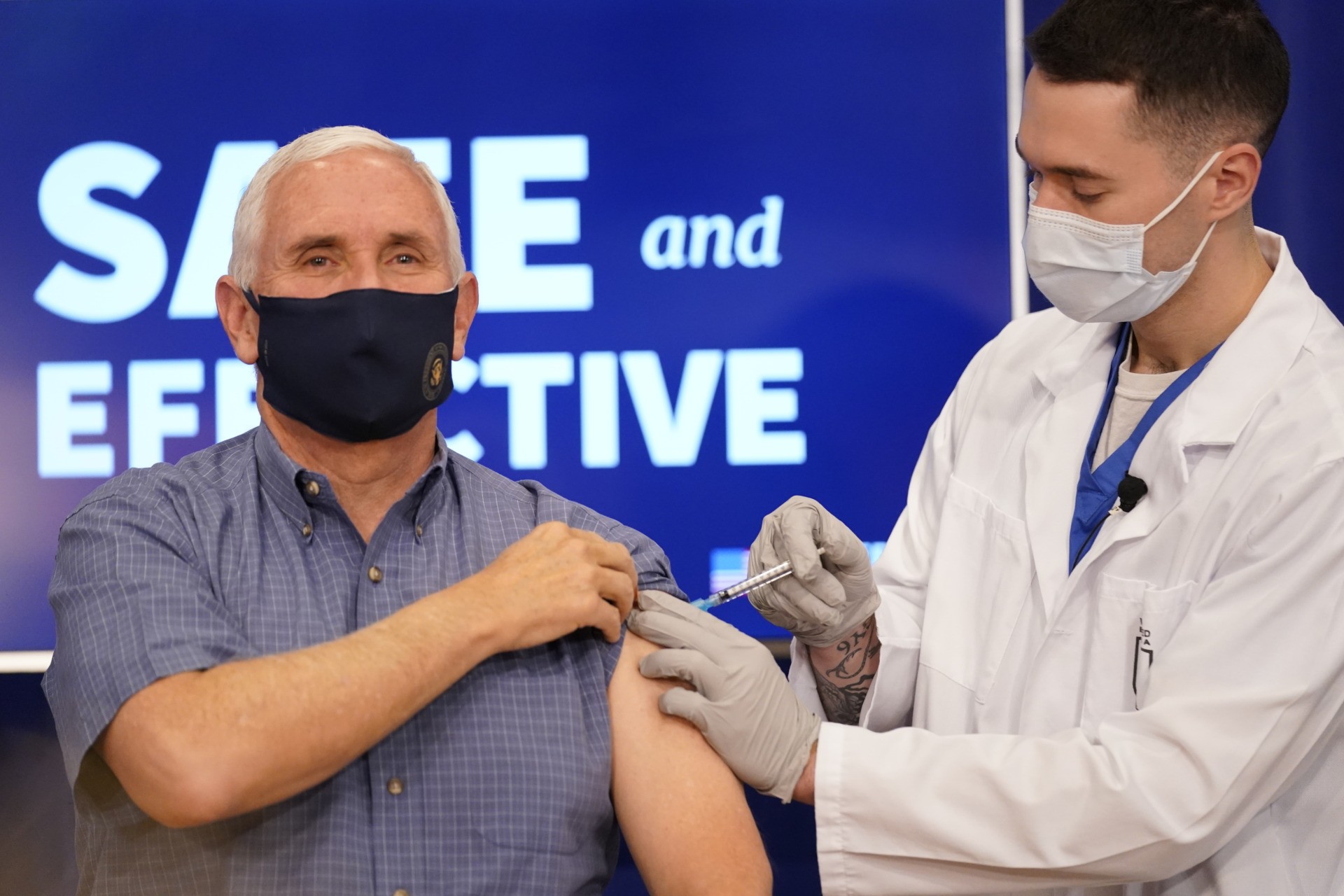
Vice President Mike Pence receives a Pfizer-BioNTech COVID-19 vaccine shot on Dec. 18, 2020, in Washington. (AP Photo/Andrew Harnik)
A Curious Subplot
Of course, even a happy story has its not-so-happy—to some, downright unhappy—elements. And that unhappy element is the exact timing of the vaccine’s announcement; a November 21 article in The New York Times suggests that Pfizer held off on announcing the vaccine until after the November 3 election. Describing the tense weeks in the run-up to the balloting, the Times wrote:
At play were not just commercial rivalries and scientific challenges but an ambitious plan to put the federal government in the middle of the effort and, most vexingly, the often toxic political atmosphere created by President Trump. Betting that a vaccine would secure his re-election, he waged both public and private campaigns to speed the [approval] process.
In particular, Dr. Albert Bourla, CEO of Pfizer, seems to have wanted to go slow—at least a little bit slow:
After promising progress on a timetable that seemed to support Mr. Trump’s prediction of a breakthrough before Election Day, Dr. Bourla pushed back the schedule in late October, fearing his firm’s clinical trial results would otherwise not be convincing enough for federal regulators to grant emergency approval of its vaccine. News of Pfizer’s success was announced just after the election was called for Joseph R. Biden Jr.
The Times story added that Pfizer chose not to ask for special early approval for the vaccine, and so the regular approval “came on Nov. 3, Election Day, or the day after.”
Now a case could be made, of course, that a pre-election vaccine announcement would have sent Democrats and their allies in the MSM and the Establishment into orbits of outrage; they would have said that Pfizer was pulling an “October Surprise” on behalf of Trump, and perhaps further added, out of knee-jerk spite, that the vaccine wasn’t to be trusted. Such an angry barrage could have tangled up the vaccine in the bureaucracy, the courts—and the court of public opinion—for weeks, months, maybe even years. Still, if the Times report is accurate, Pfizer’s delay was a gift to the Democrats.
By this reckoning, perhaps Operation Warp Speed wasn’t quite as speedy as we thought—and perhaps the Democrats, not patients, were the intended beneficiaries of the timing.
Of course, many will say that issues of drug-readiness are complicated—involving, as they do, sensitive issues of clinical trials and potential legal liability—and so we shouldn’t immediately rush to judgment about Pfizer.
Yet for his part, Trump has made a judgment: As he said on November 20, Pfizer might have taken a deliberately slow approach:
They were going to come out in October, but they decided to delay it because of what I’m doing. They waited and waited and waited.
As of now, we can only say this much for sure: The Establishment’s hostility to Trump is so thick that anything’s possible. And as evidence—if any more evidence were needed— we might consider this December 12 headline in Politico: “Biden starts countering Trump’s messaging on vaccine.” As the article detailed, the Biden people are now “believing the Trump administration has set the effort back significantly.”
So now, many of us can ask: What’s wrong with Trump’s messaging? He and his OWS team got the vaccine done, and in record time, and now they’re doing everything they can to get it distributed.
One might think that the Biden people would be happily building on what Trump has done, as opposed to “countering” him. But hey, that’s politics.
At least in the real world of health and healthcare, good things are happening. Cures are, after all, popular. As Jeremy Shane, a veteran consumer health executive, quipped, “In the face of death, people are remarkably pro life.”
The China Threat
Oh, and one last thing: World War V–World War Virus–is definitely that: a world war. Or maybe, world wars. It’s a war against the virus, that’s for sure, and yet at the same time, other countries are involved, most notably, China, with which we are in a sort of cold war–complete with spies and honey traps.
Indeed, Trump has said, many times, that the origins of Covid can be traced back to the People’s Republic of China (PRC), perhaps to its notorious Wuhan Institute of Virology; there’s plenty of evidence for that, and plenty of need for more investigation as to whether the release was, or was not, intentional.
Yet in the meantime, China has been touting its response to Covid, patting itself on the back for its tough tactics (what other kind of tactics to the communists have?) and deriding the United States for its softer response. On December 14, the New York Times reported on the words of one Wang Xiangsui, a retired senior colonel now teaching at a Beijing university: “In this fight against the pandemic, there will be victorious powers and defeated ones,” Wang said, adding of the PRC, “We’re a victor power, while the United States is still mired and, I think, may well become a defeated power.
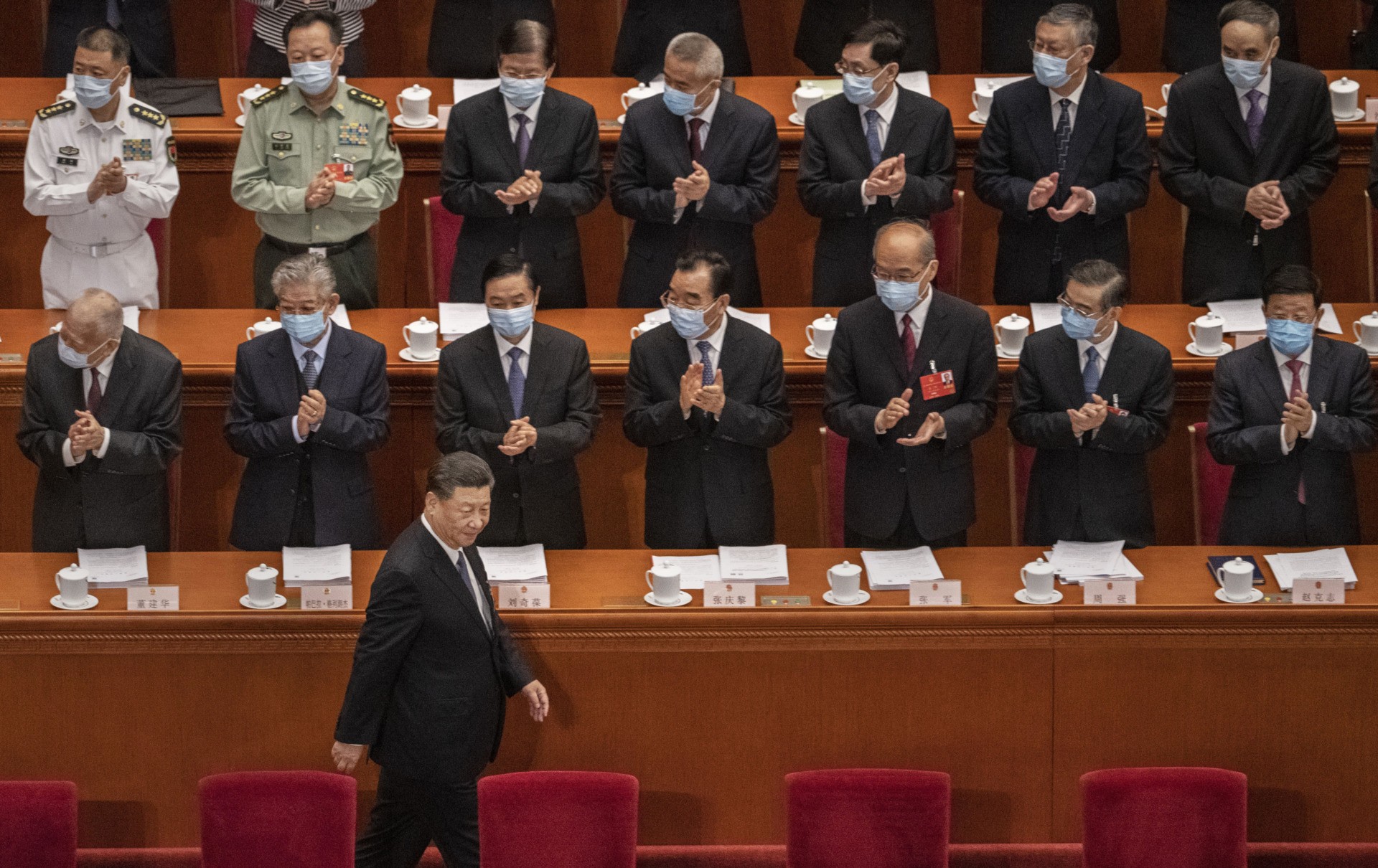
Chinese Communist Party leader Xi Jinping is applauded by delegates wearing protective masks as he arrives at the opening of the National People’s Congress at the Great Hall of the People on May 22, 2020 in Beijing, China. (Kevin Frayer/Getty Images)
As this author has argued in the past here at Breitbart News, the “optics” of world power are important, and so it’s always been vital that the U.S. do its best to present a good image to the world, whether the issue be civil rights, or public health. (And at the same time, we have to be ready to point out the bad optics of rival powers, most obviously, gross human rights violations against the Uyghurs and Falun Gong–and yes, let’s see some more real data, please, about China’s response to Covid.)
Yet in addition, we also have to look to our homeland and national security. Â On these matters, Secretary of State Mike Pompeo issued a clear warning about China just on the 13th, speaking to Breitbart News’ Alex Marlow:
They have infiltrated our schools and they spend money on research projects and so co-opt our institutions that are higher learning and research. They now infiltrate—we’ve seen this—into our government, into our businesses. President Trump called this out. We’ve begun to push back against it; there’s a lot more work to do. But make no mistake: the Chinese Communist Party presents the single greatest threat to the United States of America of our times.
So yes, the stakes are high, and the threats are grave. And yet thanks to Operation Warp Speed, we’ve done something that the Chinese haven’t done, namely, develop proven vaccines. And that’s a strong start for a healthcare cold war.
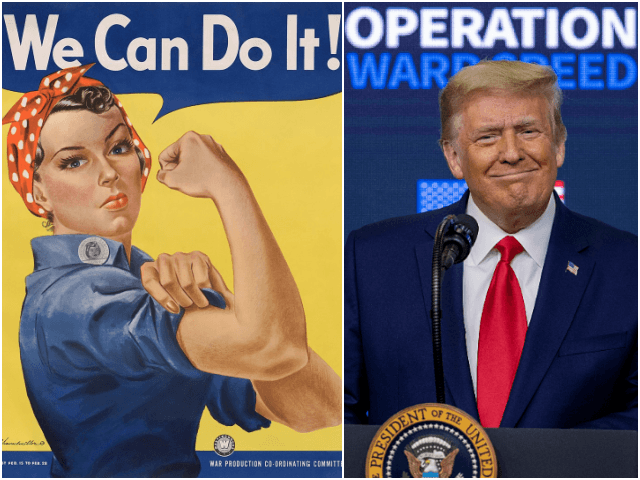
COMMENTS
Please let us know if you're having issues with commenting.